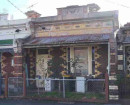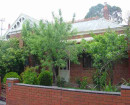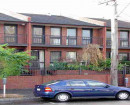Elm and ash street tree avenue
Bunbury Street FOOTSCRAY, Maribyrnong City
-
Add to tour
You must log in to do that.
-
Share
-
Shortlist place
You must log in to do that.
- Download report


Statement of Significance
This elm and ash avenue is significant to the City of Maribyrnong:
- for the combination of its maturity and extent, as compared to other street planting in the City (Criterion B2)
- as a reflection of the role of the Footscray Railway Station and the perception of Bunbury Street as one of the main entry points to the municipality (Criterion A4).
Australian Heritage Commission (AHC) criteria
The Australian Heritage Commission criteria consist of a set of eight criteria which cover social, aesthetic, scientific, and historic values. Each criterion has sub-criteria written specifically for cultural or natural values. The relevant criteria are:
B.2 rarity
A.4 demonstrates well the course and pattern of history, important historic events
-
-
Elm and ash street tree avenue - Physical Description 1
Planted as combination of elms and ash in an avenue extending east of Hyde Street to Moreland Street where they join with an oak and elm avenue. Mature trees in the block Mooreland to Whitehall- 5 (2 ash, 3 elms) on the north side, 6 (5 elms, 1 ash) on the south; Whitehall to Cowper Street - 8 on the north (2 ash, 6 elms) and 7 (4 elms, 3 ash) on the south; and Cowper to Hyde Street - 3 (1 elm, 2 ash) on the north, 4 (2 ash, 2 elms) on the south . Intermixed are immature elm plantings, planted in recent years to fill in gaps. These trees are planted in a grassed median which has basalt kerbing as an addition to the original basalt kerb and channel. Similar medians are in Cowper and Whitehall Streets. These medians appear to be after the 1895 MMBW plans but echo the placement of trees in tree guards shown in those plans.
Elms `The 20 or so species in this genus of trees and shrubs occur naturally in temperate regions of the northern hemisphere. During the 1920s and 1930s, and again in the 1960s and 1970s, elm trees in Europe and North America were devastated by Dutch elm disease, caused by the fungus Ophiostoma ulmi, which is transmitted by the elm bark beetle. Except for a few East Asian species, they are deciduous, turning yellow in fall (autumn). The leaves are usually alternate, one sided at the base, with prominent, parallel, lateral veins and regularly toothed margins; the small, disc-like fruits have a membranous wing and are carried in clusters. Most elms are large limbed with furrowed grey bark and high, domed crowns {Botanica}'.
Ash `This genus consists of 65 species of mainly deciduous, fast-growing trees, ranging throughout the northern hemisphere except for the coldest regions and lowland tropics. It differs from other woody members of the olive family (Oleaceae) in having pinnate leaves consisting of several leaflets, small insignificant flowers that in most species lack petals, and single-seeded, winged fruits botanically called samaras. One group of species known as the 'flowering ashes', typified by Fraxinus ornus, produces showier flowers with small petals in large terminal panicles at the tips of the branches. Several larger species are valued for their tough, pale timber {Botanica}.'Elm and ash street tree avenue - Physical Conditions
Good (partially disturbed, well preserved)
Elm and ash street tree avenue - Integrity
substantially intact/some intrusions
Elm and ash street tree avenue - Physical Description 2
Context
Set in a related Edwardian-era and Victorian-era residential streetscape with basalt kerb and channel, asphalt footpaths.Elm and ash street tree avenue - Historical Australian Themes
Thematic context
Australian Principal Theme Developing cultural institutions and ways of life
PAHT Subtheme Creating public landscape
Local Theme(s) Developing Local GovernmentElm and ash street tree avenue - Physical Description 3
Map (Melway) 42D5
Boundary description The trees and sufficient land around each to allow for root zone and canopy protection, nominally 1m beyond the tree centre line, root zone or canopy perimeter which ever is the greatest, plus the associated medians and stone kerbs.
Heritage Significance City
Creation date(s) 1903-8, 1930s
Local Government Area City of Maribyrnong
Ownership Type PublicHeritage Study and Grading
Maribyrnong - Maribyrnong Heritage Review
Author: Jill Barnard, Graeme Butler, Francine Gilfedder & Gary Vines
Year: 2000
Grading:
-
-
-
-
-
FORMER BARKLY THEATRE
 Victorian Heritage Register H0878
Victorian Heritage Register H0878 -
FOOTSCRAY RAILWAY STATION COMPLEX
 Victorian Heritage Register H1563
Victorian Heritage Register H1563 -
HENDERSON HOUSE
 Victorian Heritage Register H0183
Victorian Heritage Register H0183
-
'Mororo' 13 Oxford Street, Malvern
 Stonnington City
Stonnington City -
1 Arnold Street
 Yarra City
Yarra City -
1 Austin Street
 Yarra City
Yarra City
-
-












